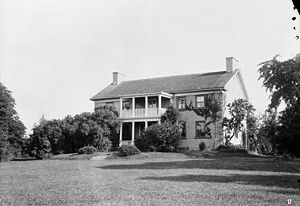- DeCou House
-
DeCew House (variably spelt DeCow, Du Coo or DeCou) was built by John DeCew, c.1808, in Thorold Township, Upper Canada. The two story house had limestone walls 66 centimetres (26 in) thick.[1]
DeCew was a captain in the 2nd Lincoln Militia during the War of 1812, and also spent almost a year as a prisoner of war. During his absence, his house was used by the British army as a detachment headquarters under the command of Lieutenant James FitzGibbon. The house is remembered as the destination of Laura Secord's celebrated journey to warn the British of a planned American attack. Thanks to her warning, FitzGibbon was prepared for the attack, and in the ensuing Battle of Beaver Dams was able to secure the surrender of an American force of approximately 500 men.[2]
Following the war, DeCew lived in the house with his wife Katharine, raising eleven children and operating a mill a short distance away. He sold the house when he relocated to Haldimand County in 1834. The house was purchased by David Griffiths, and he and his descendants occupied the house until 1942. At that time, the property was acquired by the Hydro-Electric Power Commission of Ontario (a predecessor of Ontario Power Generation). Most of the surrounding land was flooded to create Lake Gibson as a reservoir for hydroelectric power generation purposes. The house, being on high land, was not flooded and continued to stand unoccupied. In 1950, it was destroyed by fire under suspicious circumstances. [3]
Due to the historical significance of the structure, the lower part of the stone walls were preserved. The Power Commission installed a flagstone floor and a plaque explaining the history of the structure.
In January, 2008, John Burtniak, chair of Thorold's War of 1812 bicentennial committee, urged the City of Thorold to acquire the property to assure the protection of this important historical asset.[4] However, Thorold Council rejected the proposal citing the cost of upkeep.[5] Despite this, the City of Thorold assumed ownership of the DeCou House in early 2011 from the Ontario Power Generation for a nominal fee, completing a restoration project in October of that year.[5]
References
- ^ "Ontario Power generation – DeCew Falls 1". http://www.opg.com/power/hydro/niagara_plant_group/decew1.asp. Retrieved 2008-05-18.
- ^ Collins, Gilbert (2006). Guidebook to the Historic Sites of the War of 1812. Toronto: Dundurn Press Ltd.. pp. 153–154. ISBN 1550026267.
- ^ "Webshots – DeCou House 4". http://outdoors.webshots.com/photo/1049333471027797469uzmFkq. Retrieved 2008-05-21.
- ^ Draper, Doug (2008-01-18). "Buy DeCew House where Secord's Famous Walk Ended, Thorold Urged". Niagara This Week.
- ^ a b "Thorold won't take DeCew House off Crown corp.'s hands". http://www.stcatharinesstandard.ca/ArticleDisplay.aspx?e=1303771. Retrieved 2008-12-19.
Coordinates: 43°06′28″N 79°15′01″W / 43.10778°N 79.25028°W
Categories:- Houses in Ontario
Wikimedia Foundation. 2010.

